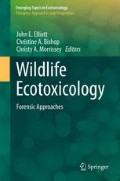Abstract
This introductory chapter provides an overview of the book and some discussion of the emergent themes. The nature of forensic ecotoxicology is considered, and a definition proposed. We reflect on the experiences of some authors in trying to translate scientific evidence of toxicant effects into regulatory or non-regulatory action. We further examine the problem of bias in data interpretation, and consider some of the dispute resolution processes discussed by the various authors.
Access this chapter
Tax calculation will be finalised at checkout
Purchases are for personal use only
References
Amster R (2006) Perspectives on ecoterrorism: catalysts, conflations, and casualties. Contemp Justice Rev 9:287–301
Barrow CS, Conrad JW (2006) Assessing the reliability and credibility of industry science and scientists. Environ Health Perspect 114:153–155
Beck U (1992) Risk society: towards a new modernity. Sage, London, p 252
Bella DA (1992) Ethics and the credibility of applied science. In: Reeves GH, Bottom DI, Brookes MA (eds) Ethical questions for resource managers. U.S. Dept Agriculture, Forest Service, General Technical Report PNW-GTR-288. Portland, OR, USA. pp 19–32
Bella DA (2004) Salmon and complexity: challenges to assessment. Hum Ecol Risk Assess 8:55–73
Blus LJ (2003) Organochlorine pesticides. In: Hoffman DJ, Rattner BA, Burton GA, Cairns J (eds) Handbook of ecotoxicology. CRC, Boca Raton, FL, pp 313–339
Bradshaw CJA, Sodhi NS, Brook BW (2009) Tropical turmoil: a biodiversity tragedy in progress. Front Ecol Environ 7:79–87
Brahic C (2010) Climategate scientist breaks his silence. New Sci 207(2771):10–11
Carson RL (1962) Silent spring. Houghton Mifflin, Boston, MA, p 368
Cravey RH, Baselt RC (1981) The science of forensic toxicology. In: Cravey RH, Baselt RC (eds) Introduction to forensic toxicology. Biomedical, Davis, CA, USA
Dudley JP, Ginsberg JR, Plumptre AJ, Hart JA, Campos LC (2002) Effects of war and civil strife on wildlife and wildlife habitats. Conserv Biol 16:319–329
Hites RA (2004) Polybrominated diphenyl ethers in the environment and in people: a meta-analysis of concentrations. Environ Sci Technol 38:945–956
Huss A, Egger M, Hug K, Huwiler-Muntener K, Roosle M (2007) Source of funding and results of studies of health effects of mobile phone use: systemic review of experimental studies. Environ Health Perspect 115:1–4
Lackey RT (2002) Values, policy and ecosystem health. Bioscience 51:437–453
Le Billon P (2001) The political ecology of war: natural resources and armed conflicts. Polit Ecol 20:561–584
Marr-Liang T, Severson-Baker C (1999) Beyond eco-terrorism: the deeper issues affecting Alberta’s oilpatch. Pembina Institute, Drayton Valley, AB, p 26
McCormick J (1989) Reclaiming paradise. Indiana University Press, Bloomington, ID, USA, p 259
New Scientist (2010) End dirty tactics in the climate war: editorial. New Sci 207(2771):3
Newton I, Wyllie I, Asher A (1992) Mortality from the pesticides aldrin and dieldrin in British Sparrowhawks and Kestrels. Ecotoxicology 1:31–44
Ofiara D (2002) Natural resource damage assessments in the United States: rules and procedures for compensation from spills of hazardous substances and oil in waterways under US jurisdiction. Mar Pollut Bull 44:96–110
Princeton University (2010) Wordnet. http://wordnet.princeton.edu/.
Ratcliffe D (1980) The peregrine falcon. T & AD Poyser, Calton, UK, p 416
Rattner BA (2009) History of wildlife toxicology. Ecotoxicology 18:773–783
Rohr JR, McCoy KA (2010) Preserving environmental health and scientific credibility: a practical guide to reducing conflicts of interest. Conserv Lett 3:143–150
Rosenstock L (2002) Attacks on science: the risks to evidence-based policy. Am J Public Health 92:14–18
Sieber JE (2006) Quality and value: how can we research peer review? Nature. doi:10.1038/nature05006
Smith R (2006) Peer review: a flawed process at the heart of science and journals. J R Soc Med 99:178–182
U.S. EPA (United States Environmental Protection Agency) (2002) Overview of the panel formation process at the Environmental Protection Agency Science Advisory Board. EOA-SAB-EC-02-010, U.S. Environmental Protection Agency, Washington, DC
Author information
Authors and Affiliations
Corresponding author
Editor information
Editors and Affiliations
Rights and permissions
Copyright information
© 2011 Springer Science+Business Media, LLC
About this chapter
Cite this chapter
Elliott, J.E., Bishop, C.A., Morrissey, C.A. (2011). Wildlife Ecotoxicology: Forensic Approaches. In: Elliott, J., Bishop, C., Morrissey, C. (eds) Wildlife Ecotoxicology. Emerging Topics in Ecotoxicology, vol 3. Springer, New York, NY. https://doi.org/10.1007/978-0-387-89432-4_1
Download citation
DOI: https://doi.org/10.1007/978-0-387-89432-4_1
Published:
Publisher Name: Springer, New York, NY
Print ISBN: 978-0-387-89431-7
Online ISBN: 978-0-387-89432-4
eBook Packages: Earth and Environmental ScienceEarth and Environmental Science (R0)

